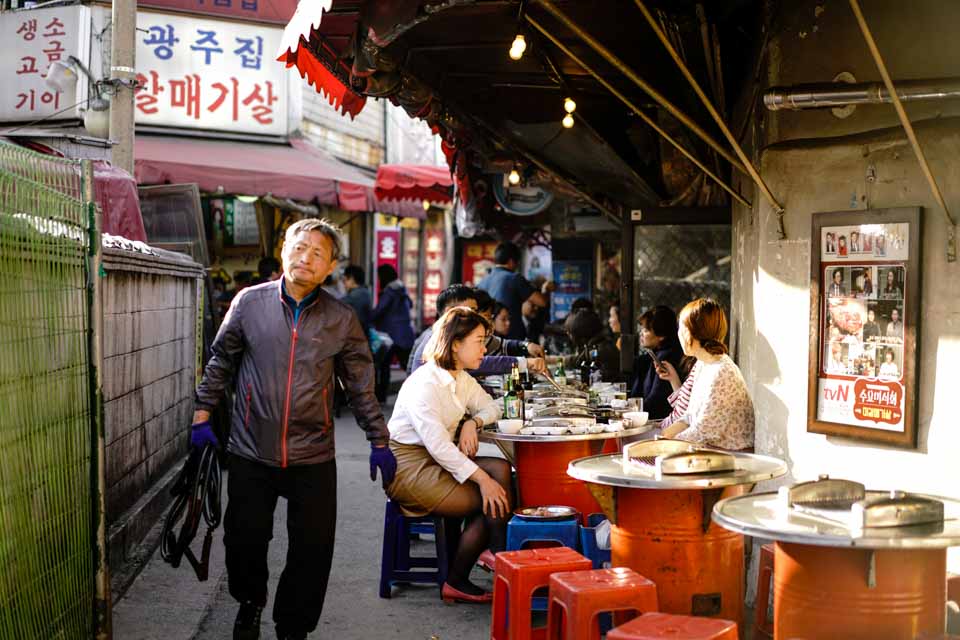
Grilled Pork Belly: A South Korean Love Story
Near Exit 6 of Jongno 3-ga station in Seoul is an area famous for its barbeque joints. As an alley gives way to a three-way intersection, easily two dozen eateries overflow with patrons flipping samgyeopsal slices and pouring soju shots.
“I’ve been sourcing pork belly from the same farmers for over 20 years,” said Park Jin-suk, the 62-year-old proprietor of Tongdwaejijip, one of the first pork barbecue places to open in the famous “meat alley” of Jongno. Park prides herself on using quality pork, supplied by the farmers with whom she has built a relationship since her restaurant opened 21 years ago. The farmers, a newly-wed couple when Park first approached them, have become more than business associates. Park even sends their children birthday presents.
“They put aside the best-quality meat for me,” she said proudly.
In Park’s opinion, what defines good-quality pork belly, called samgyeopsal in Korean, is the correct ratio between fat and lean meat that helps strike the delectable balance between greasyness and meatyness (samgyeopsal literally means three-layered meat).
“Look how pretty this hand-cut pork belly is,” she boasted, taking a plate of pre-sliced meat out of a fridge.

Favored by locals and foreigners alike, grilling pork belly is a serious business in South Korea. Samgyeopsal has become so integral to contemporary Korean cuisine that most neighborhoods in big cities boast several barbecue restaurants serving pork as their main item. Yet grilling pork is a relatively recent adoption in South Korea, and its precise origins are hard to pin down.
Koreans have long preferred beef over pork, a predilection that dates back as far as the Joseon Dynasty. Joo Young-ha, a food expert and visiting professor at the University of British Columbia, wrote in his book, A Korean History on the Dinner Table, that until the early 1970s, eating pork was associated with greying hair and even lethal parasite infestations.
Even when pork was eaten, it was rarely grilled; due to scarcity, the meat was mostly boiled as a soup ingredient, making it go as far as possible.
The practice of grilling may have been adopted as a necessity. “I believe grilling meat became popular during the Korean War (1950-53),” Joo told me via email. “At that time, people had to grill and eat the meat right away once they had any.” He added that the word bulgogi, literally ‘fire meat,’ had “entered the popular lexicon after the war.”
On top of that, Joo said, Koreans had preferred steaming over grilling due to a lack of available utensils. But from the 1960s, when briquets became more widespread as a source of fuel, people started grilling meat on griddles over briquet fires.
“Steel drums from the fledgling oil industry and U.S. military bases proved to be effective for grilling meat outdoors,” Joo said. Some barbecue restaurants still emulate drum-turned-table designs, with round steel plates that encloses the griddle atop a drum.

Meat consumption saw a rise in keeping with South Korea’s steep economic growth in the 1970s and thereafter. Overall meat consumption grew over tenfold between 1970 and 2016 (from 5.2 to 55.9 kilograms per person). But pork still stands out for its popularity, having been the most heavily consumed type of meat since 1970 (when data first became available).
Between 1977 and 1979, South Koreans’ per capita pork consumption jumped by around one kilogram each year. While this may not seem like a lot, the years that preceded 1977 saw an average annual increase of just 0.1 kg — and sometimes even a decrease. Over the same period (1978-79), beef consumption rose by 0.8 kg and chicken by 0.2 kg.

As to how grilling pork belly has become so popular deserves an account of its own. “The history of pork belly barbecue differs according to region,” said food expert Joo. “At times of rapid urbanization, such as the during the development of Yeouido Island [in Seoul], rural migrants drove the heavy consumption of pork, which was cheap.”
The construction in 1970 of Mapo Bridge, connecting Yeouido to central Seoul, led to a construction boom on the island. Soon, migrants who congregated near Yeouido seeking jobs started grilling cuts of pig meat that weren’t previously consumed, including skin, skirt meat (from near the diaphragm and belly) and belly, Joo said.
He added that a plethora of barbecue eateries around Mapo and Gongdeok, still famous to this day, opened at that time. Seongnam, a satellite city south of Seoul, also became known for skirt meat due to its high concentration of migrants.
Busan has a different story. Located in the southeast of the peninsula, the coastal city developed its own way of cooking pork thanks to its geographical proximity to Japan.
In 1965, South Korea and Japan normalized diplomatic relations, twenty years after Korea was liberated from Japan after WWII. Trade with Japan increased in the 1970s, and the South Korean pork industry started expanding to supply the Japanese market. Under military dictator Park Chung-hee, the New Village Movement — a political initiative to modernize the rural economy — promoted the country’s pig raising industry. By 1979, the number of pigs bred in captivity had more than doubled from the 1970 figure, to 2.8 million, according to a report by the National Institute of Animal Science.
But samgyeopsal, due to its oleaginousness, proved unpopular with Japanese diners. So people living around Busan, home to many slaughterhouses catering to the export market, came up with creative ways to cook the meat and eat it themselves: “First they marinated pork belly in soy sauce, so as to emulate bulgogi, a marinated beef dish. Then they added gochujang [red chili paste] to create a stir-fried pork dish,” Joo said.
The repertoire eventually expanded to include what is currently the most common form of samgyeopsal: morsels of grilled pork belly placed on a lettuce leaf with steamed rice, garlic cloves and soybean paste to make a bite-sized wrap (ssam). According to Joo, ssam existed even in the late Joseon Dynasty, but usually with raw fish slices and fermented fish sauce wrapped in the leaves.

1977 was a pivotal year for the nascent domestic pork industry. Exports to Japan faltered that year, leading to a significant drop in price of pork on the South Korean market due to oversupply. Seeing it as a cheap alternative to beef, South Koreans started turning to pork. The government’s deliberate agenda of reducing the national preference for beef, which led to price fluctuations, also affected consumption.
Daily newspaper Donga-ilbo’s 1977 editorial section gave support for the government’s tentative plan, which was to designate Saturday “Let’s Not Eat Beef Day.”
“In terms of nutrition, beef, pork and chicken are the same,” said the paper. “For the cost of a man eating beef at a restaurant, his entire family can eat pork three to four times at home,” it added.
To most people at that time, “It didn’t matter whether they were eating pork belly or ribs,” said Park Dea-seob, professor of restaurant business and nutrition at Seoul’s Sangmyung University. With their recent experiences of poverty and war, South Koreans associated meat-eating with abundance and wealth. They would eat any kind of meat they could afford.
It was only from the late 70s, Park said, that South Koreans became more discerning consumers of meat, distinguishing between different parts such as ribs, belly and skirt meat.
Another important development: By the early 80s, pork belly became a popular match with soju — cheap alcohol industrially distilled from surplus grains and vegetables — making barbecue a quintessential social experience at restaurants, homes and up on mountains (grilling meat in mountains was outlawed only in 1998, due to fire hazard and environmental contamination). A 1983 Donga-ilbo article explains how worn-out salarymen would opt for pork belly with soju, instead of going to more expensive bars or room salons, to let off steam.
Read: “Soju Globalization: From Green Bottle to Premium Label”
That tradition of grilling samgyeopsal as a communal experience remains strong. Kwon Ye-sol, 25, is a self-proclaimed samgyeopsal enthusiast, and pork belly is the go-to dining option among her peers.
“It’s reasonably priced, especially for young people like me,” said Kwon, who says she eats it almost every week. “Besides, most people like samgyeopsal, unlike other types of meat,,” she added.
So strong is the association between grilled pork belly and socializing that some who live alone, like 27-year-old Noh Young-eun, are deterred from eating it.
“I used to love eating pork belly, but always saw it as food to share with friends and family,” Noh said. “Since I’ve lived alone, pork belly has disappeared from my life,” she added.
Once, craving pork belly but lacking a companion to go out and eat it with, she went to a neighborhood butcher who scoffed at her for wanting to buy only one portion. “That’s when I truly felt how difficult it is to eat pork belly alone,” Noh said.
But as the number of single households increases in South Korea, businesses are starting to offer one-person samgyeopsal options for people like Noh. Baemin, South Korea’s biggest food delivery platform, offers a set of grilled pork belly, lettuce, condiments and kimchi stew with rice — everything you would get at a restaurant. Those who still want to venture outside also have the option of barbecuing alone.

Samgyeopsal is inseparable from South Korea’s economic ebbs and flows. If its advent had to do with the expanding economy, urbanization and export industry in the 70s, it was during the 1997 Asian Financial Crisis — colloquially dubbed the “IMF Crisis” — that pork belly became the epitome of South Korean barbecue. Due to its affordability, families and companies dined out at pork belly joints instead of beef barbecue restaurants. “The demand for samgyeopsal exploded,” said Joo.
In 1999, over 27 percent of respondents to a survey conducted by the Korea Rural Economic Institute claimed that they bought pork because it was “cheaper than beef.” 66.7 percent chose samgyeopsal when purchasing pork.
Today, pork belly has become more than just a cheap alternative. “Samgyeopsal enriches my life,” said samgyeopsal enthusiast Kwon as she planned her next trip to a barbecue joint.
Pork belly is no longer cheap; over the years, high demand and general inflation have raised its price, spawning the portmanteau geum-gyeopsal — “gold pork belly.” But it largely remains a cheaper — and hence popular — choice of meat for many South Koreans.
As the demand for pork belly grew, South Korea started importing pork. In 2015, over 350,000 tons of the meat was imported, despite the increasing number of domestically raised pigs. 40 percent of imported pork was belly meat. But some, like Tongdwaejijip owner Park at Jongno’s meat alley, insist on grilling only domestically sourced meat.
“Imported pork belly, put simple, is pork belly only by appearance. It tastes bad, really bad,” she said.

Despite new barbecue restaurants opening up next door, Park is confident that her business will continue to thrive, and I couldn’t see why she wouldn’t be. As I walked out of her establishment, golden light shone on patrons who arrived early to watch pork belly sizzle on grills and crack open green bottles of soju. It was nearing the end of the working day, and fatigued office workers were slowly taking their seats and loosening their ties in preparation for their feast, and the neighborhood was already filling with meaty fumes and loud chatter.
Cover image: Near Exit 6 of Jongno 3-ga station in Seoul is an area famous for its barbeque joints. (Jieun Choi/Korea Exposé).

